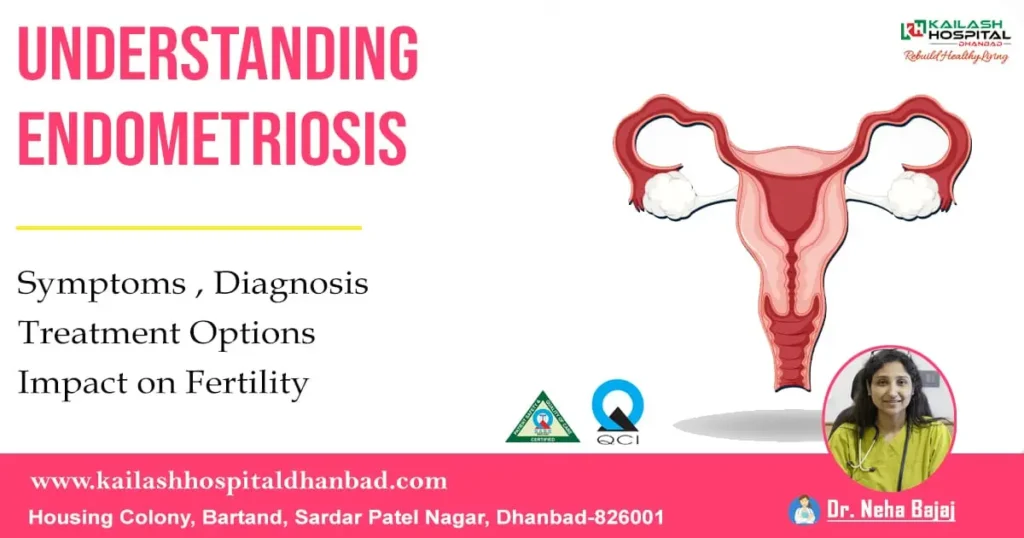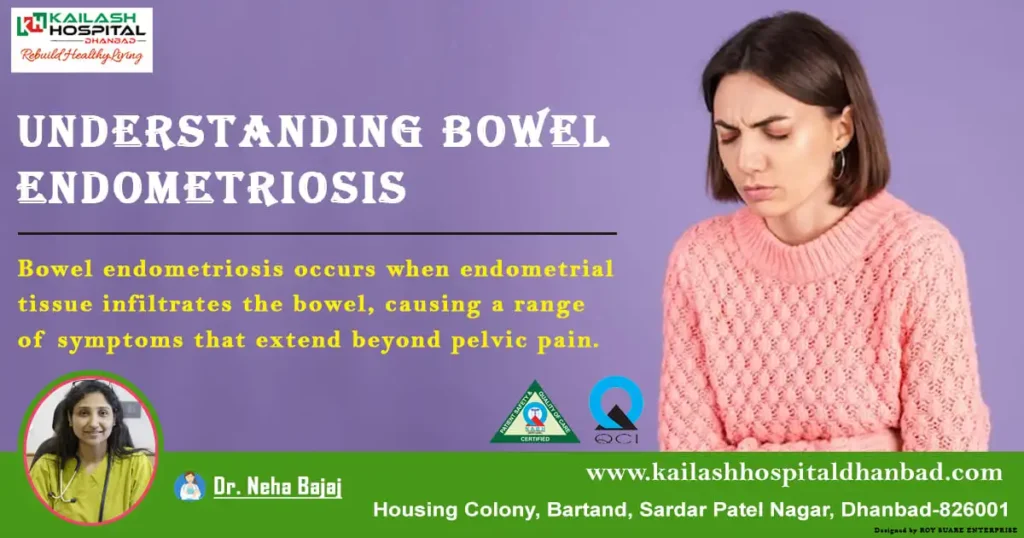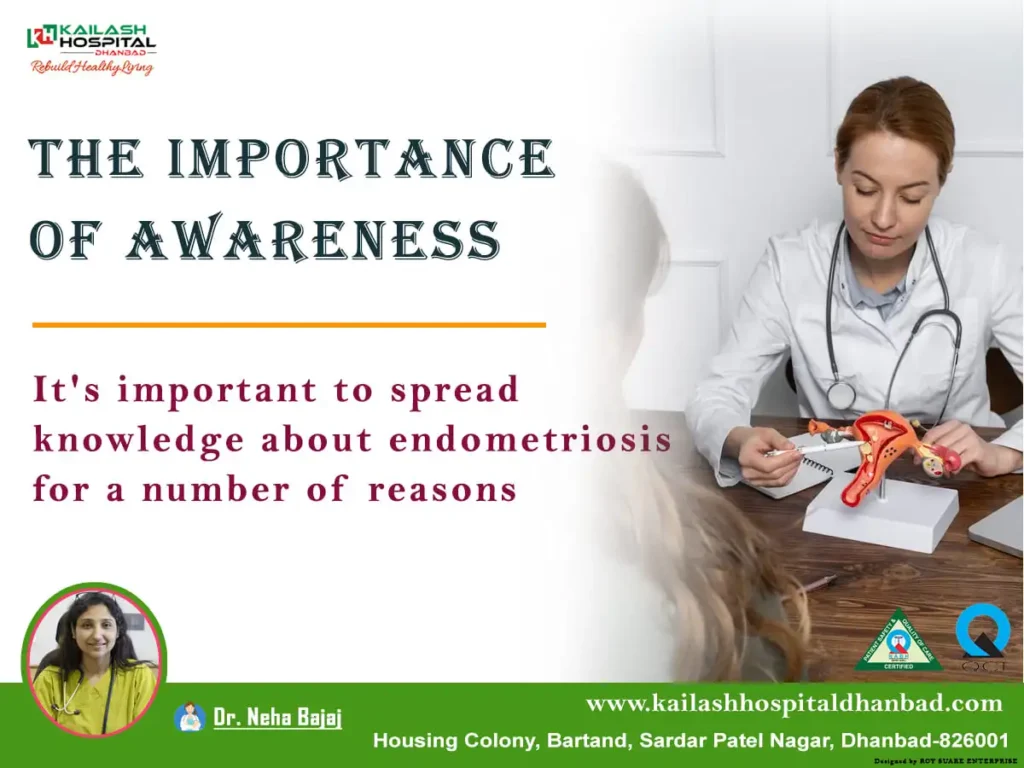Table of Contents
Endometriosis is a complex and often misunderstood medical condition that affects millions of women worldwide. Despite its prevalence, the lack of awareness surrounding endometriosis often leads to delayed diagnosis and inadequate management. In this blog post, we will delve into the intricacies of endometriosis, shedding light on its symptoms, diagnosis, and various treatment options, while also emphasizing the importance of raising awareness about this invisible but impactful condition.

Understanding Endometriosis:
Endometriosis is a condition in which tissue similar to the lining of the uterus, known as the endometrium, grows outside the uterus. This tissue can be found in organs such as the ovaries, fallopian tubes, and the lining of the pelvic cavity. Unlike the normal endometrial tissue, the displaced tissue has no way to exit the body, leading to inflammation, pain, and the formation of scar tissue.
Symptoms:
The symptoms of endometriosis can vary widely, with some women experiencing severe pain, while others may have no noticeable symptoms. Common signs include:
- Pelvic Pain: Chronic, debilitating pain is a hallmark of endometriosis, often intensifying during menstruation.
- Painful Menstruation: Dysmenorrhea, or severe menstrual cramps, is a prevalent symptom.
- Infertility: Some women with endometriosis may struggle with fertility issues.
While these are hallmark signs, there exists a spectrum of lesser-known and uncommon symptoms associated with endometriosis that often go unnoticed or are misattributed to other causes. Now, we will explore these less-discussed symptoms, shedding light on the multifaceted nature of endometriosis and the importance of recognizing these signs for early diagnosis and improved management.
Gastrointestinal Distress:
Unexplained digestive issues such as bloating, constipation, diarrhea, and abdominal cramping can be linked to endometriosis. The abnormal growth of endometrial tissue in the pelvic region may affect the nearby gastrointestinal organs, leading to discomfort and irregular bowel movements.
Urinary Symptoms:
Some women with endometriosis may experience urinary symptoms such as frequent urination, urgency, or even pain during urination. The proximity of endometrial implants to the bladder or ureters can contribute to these issues.
Fatigue and Weakness:
Chronic fatigue and a persistent feeling of weakness are often overlooked symptoms of endometriosis. The condition’s impact on the immune system, coupled with the body’s continuous battle against inflammation, can contribute to overall feelings of exhaustion.
Painful Intercourse (Dyspareunia):
While dyspareunia is recognized as a symptom, it often takes a backseat to more prominentsigns. Pain during or after intercourse can be a distressing and often unspoken symptom of endometriosis, affecting the emotional well-being of individuals.
Back and Leg Pain:
The pelvic pain associated with endometriosis can radiate to the lower back and legs. This radiating pain, often chronic and unexplained, is another aspect that individuals with endometriosis may contend with on a daily basis.
Cyclical Allergies and Immune System Dysfunction:
Some women with endometriosis may experience cyclical changes in their immune response, leading to increased susceptibility to allergies or autoimmune conditions. Understanding these patterns can be crucial for managing overall health.
Chest Pain and Shortness of Breath:
Although rare, endometriosis can affect the diaphragm and even the lungs, leading to symptoms such as chest pain and shortness of breath. This underscores the systemic nature of endometriosis and the potential for symptoms beyond the pelvic region.
Recognizing the uncommon symptoms of endometriosis is essential for early detection and comprehensive management. By broadening our understanding of this complex condition, we can empower individuals to seek medical attention when faced with a range of symptoms, even those seemingly unrelated to the reproductive system. Creating awareness about the diverse manifestations of endometriosis is a crucial step towards better support, empathy, and ultimately, improved quality of life for those living with this often-misunderstood condition.
Diagnosis:
Diagnosing endometriosis can be challenging, as symptoms may overlap with other conditions. Typically, diagnosis involves a combination of medical history review, pelvic exams, imaging studies, and in some cases, laparoscopic surgery for definitive confirmation.
Treatment Options:
Although endometriosis cannot be cured, there are a number of therapeutic options that can help control symptoms and enhance quality of life. These include:
- Pain Medications: Over-the-counter pain relievers or prescription medications may help alleviate pain.
- Hormonal Therapies: Birth control pills, hormone therapy, and GnRH agonists can regulate hormonal fluctuations and reduce symptoms.
- Surgery: Laparoscopic surgery to remove endometrial tissue and adhesions is a common option, especially for those with severe symptoms or fertility issues.
Understanding Bowel Endometriosis:

Bowel endometriosis occurs when endometrial tissue infiltrates the bowel, causing a range of symptoms that extend beyond pelvic pain. This form of endometriosis can affect the rectum, colon, and other parts of the gastrointestinal tract, leading to symptoms like abdominal pain, bloating, constipation, and sometimes rectal bleeding during menstruation.
Impact on Fertility:
For individuals with bowel endometriosis, concerns about fertility often loom large. The proximity of the affected bowel to reproductive organs can lead to several challenges:
- Adhesions and Scarring:
The presence of endometrial tissue on or around the bowel can lead to the formation of adhesions and scar tissue. These adhesions may cause organs to stick together, potentially impacting the function of the ovaries, fallopian tubes, and uterus.
- Altered Pelvic Anatomy:
Bowel endometriosis can alter the normal anatomy of the pelvis, creating an environment that is less conducive to conception. This can affect the egg’s journey through the fallopian tubes and the implantation of a fertilized egg in the uterus.
- Inflammation and Immune Response:
Chronic inflammation associated with bowel endometriosis may contribute to an unfavorable reproductive environment. The body’s immune response to endometrial implants can also affect the delicate balance necessary for successful conception.
Management and Treatment Options:
Managing bowel endometriosis and its impact on fertility requires a multidisciplinary approach involving gynecologists, colorectal surgeons, and fertility specialists. Here are some common strategies:
- Medical Management:
Hormonal therapies, such as birth control pills or GnRH agonists, may be prescribed to manage symptoms and slow the progression of endometriosis. However, these treatments may not directly improve fertility.
- Surgical Intervention:
In cases where symptoms are severe or fertility is a concern, surgical removal of endometrial tissue from the bowel may be considered. This often involves collaboration between gynecological and colorectal surgeons.
- Assisted Reproductive Technologies (ART):
Fertility treatments, including in vitro fertilization (IVF), may be recommended for individuals with bowel endometriosis. By bypassing potential obstacles within the reproductive system, ART offers a path to conception.
Bowel endometriosis presents unique challenges, especially concerning fertility. Understanding the interplay between these two aspects is crucial for informed decision-making and comprehensive management. As medical science continues to advance, individuals facing bowel endometriosis and fertility concerns can find hope in the growing array of treatment options available. By fostering awareness and open dialogue, we contribute to a supportive environment for those navigating the complexities of bowel endometriosis and its impact on the journey to parenthood.
The Importance of Awareness:

It’s important to spread knowledge about endometriosis for a number of reasons. First and foremost, increased awareness can contribute to earlier diagnosis and intervention, reducing the long-term impact on a woman’s reproductive health. Moreover, understanding endometriosis helps dispel myths and misconceptions surrounding menstrual health, fostering empathy and support for those affected by this condition.
Endometriosis is more than just a physical ailment; it is a silent struggle that many women face. By understanding the symptoms, diagnosis, and treatment options, we can empower individuals to seek timely medical assistance and support. Through increased awareness, we can break the silence surrounding endometriosis, fostering a more compassionate and informed society. Together, we can unmask endometriosis, paving the way for better care, support, and ultimately, a brighter future for those affected by this invisible pain.



